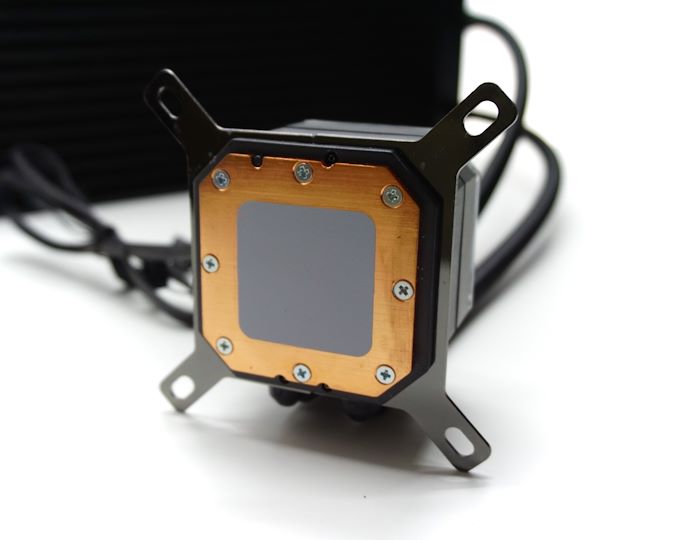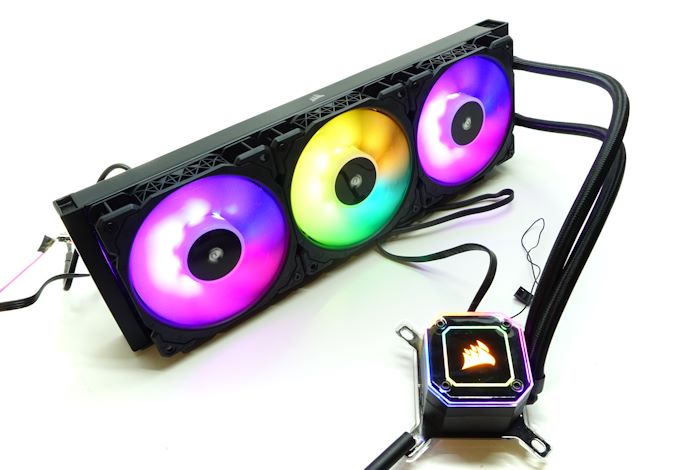The Corsair H150i Elite Capellix AIO Cooler Review: Go Big Or Go Home
by E. Fylladitakis on October 15, 2020 9:30 AM EST- Posted in
- Cases/Cooling/PSUs
- Corsair
- Water Cooling
- Liquid Cooling
- RGB
- iCUE
Conclusion
All-in-one CPU coolers first hit the market in force over a decade ago, which since then has allowed for more than enough time for developers to optimize their thermal performance, leaving little room for additional raw performance advancements. Nowadays, with many manufacturers retailing AIO cooler solutions, the market is pretty much saturated, a common outcome in the world of PC parts. Because of this, Corsair is always striving to maintain a competitive advantage by designing products with unique features, which is what made the release of the H150i Elite Capellix an anticipated move.
Where the H150i Elite Capellix has the lead over most of the competition is in terms of quality. Corsair ensured that their top AIO cooler is very well made, with excellent materials and a solid overall build quality. They also supply top-tier and fairly expensive MagLev cooling fans with the cooler, something that is often overlooked despite the fans being one of the most important parts of an AIO cooler.
The prime marketing feature of the H150i Elite Capellix is the included Commander CORE module and its compatibility with Corsair’s iCUE ecosystem. This opens up practically limitless user-programmable options, both aesthetic and practical. Except from the versatility that the iCUE software affords to the H150i Elite Capellix itself, it also enables greater control over other system fans and lights, allowing for system-wide lighting programming and sensory input. For example, it is easy to change the lighting of the cooler depending on which gaming profile is selected or for all compatible devices to share exactly the same lighting effect. The disadvantage of this feature is simple and obvious – this kind of total synergy only works with iCUE compatible devices, meaning that not even all of Corsair’s products are compatible with this feature.
However when it comes to performance, the H150i Elite Capellix barely any better than the H150i Pro RGB that the company released two years ago. We suspected as much from before we tested the cooler, as it is obvious that both coolers share the same radiator and tubing. The H150i Elite Capellix technically leads our thermal performance charts but the very powerful 2400 RPM fans are primarily responsible for this, which actually damage the cooler’s noise-to-performance ratio. Running the fans of the H150i Elite Capellix at the same speed as the fans of the H150i Pro RGB yields virtually the same performance, with but a tiny advantage for the H150i Elite Capellix – an advantage so small that can easily be a statistical error. Regardless, the quick fans provided with the H150i Elite Capellix offer greater versatility, as they can be programmed to stay quiet but also can be made loud if, for whatever reason, the user needs them to be.
Although the H150i Elite Capellix does not have a distinct performance advantage over the previous generation of cooler, its MSRP of $189 actually is reasonable and competitive. Despite the included Commander CORE, iCUE compatibility, and other minor upgrades, it's the same MSRP as the older H150i Pro RGB, making for a pleasant surprise as it means Corsair hasn't raised priced. In fact, it's generally priced close to – or even lower than – most of its direct competition. So from a performance standpoint, although Corsair hasn't managed to really move the needle on performance or pricing for their new cooler, the latest H150i is (still) just as competitive as the previous version.
Ultimately, this means that although we can't recommend the H150i Elite Capellix as an upgrade over a previous-generation cooler, Corsair continues to deliver a solid AIO cooler as far as new builds are concerned. The small quality of life improvements that come with newest H150i will help ensure that Corsair keep its advantage with unique features, all the while offering a better value to users that are considering a large AIO cooler today.













37 Comments
View All Comments
bigi - Thursday, October 15, 2020 - link
Shiat is getting ridiculous. I miss the days where computer parts did not emit light, blinks, and weren't designed for 12 year olds.khanikun - Thursday, October 15, 2020 - link
Why you can buy parts from other companies that don't do that. There's nothing wrong with having lots of options. I would like companies to have 3 options for these kind of things. No fans, has fans, and has RGB fans. Course I don't think any AIO manufacturers sell them without fans.ANoNameX - Monday, October 19, 2020 - link
@ Ian Cutress - it would be great to know if the base plate would cover the heat spreader of an sTRX4 Threadripper. It's basically the #1 concern for AIO coolers with Zen2 Threadrippers.BattleRam - Thursday, October 22, 2020 - link
Cmon no comparison to a Noctua D15 ? I know it is not an water cooler but I wish we could know exactly how much better than the best aircooler this new Corsair is.Tom Sunday - Sunday, November 1, 2020 - link
I always grow suspicious when companies use the word ELITE. But CAPELLIX what a nice new word thrown into the AIO market basket! Looks like Corsair's AIO dominance continues with all of its LED splendor (or circus action) still trying to making the big $$$ and profits. For sure the "cool Capellix'' price of $190 is not for the average blue collar Joe like me working midnights riding the forklift. But now Intel with especially the "heat on by AMD" will be pushing out their 12th Generation (10nm-Fin) Alder Lake program probably just before the 2021 Holidays? The Big Deal: The socket dimensions for the newly Alder Lake mandated LGA-1700 is about 7.5mm taller than Intel's current LGA 1200 socket and this forcing that all future mobo architectures will be dramatically changing along with their graduation to DDR5 and much more. Meaning that the H150i Capellix (along with all their other competing AIO siblings) will essentially be obsolete by the end of next year since the current chipset AIO water blocks will not fit the new CPU molds. This of course will first only be applying to system upgraders, but nevertheless and with AIO's supposed to be lasting 5-years or so, it will most certainly make people think twice before investing in a new or upgraded (costly) AIO in the months to come? I am curious in how the industry or sellers will handle this matter? Or will it be just for the enthusiast or those havng money to burn to simply starting over and or further supporting the seemingly neverending AIO upgrade craze? Unless of course we are ready now to create a used AIO market like the existing and booming 'used GPU's now being proffered. Would you buy a used Capellix? Thoughts?Damorejordane - Wednesday, November 4, 2020 - link
Admittedly a super product, I can listen and download music comfortably on https://tonurideapelgratuite.com/alex31g - Friday, August 13, 2021 - link
I have a noob question. Is this one has better cooling performance than NZXT X63 RGB?